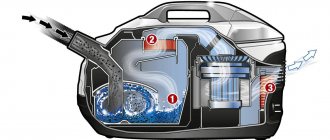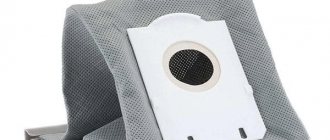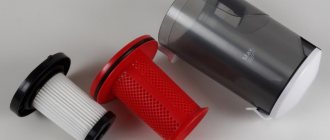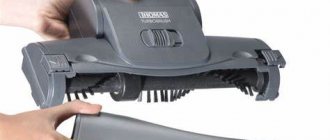Types of power
Only two power formats play a role:
- The force with which air penetrates inside.
- Electricity consumption.
The vacuum cleaner requires about 1500-2500 W, suction power is limited to 350-500 W. For a small city apartment, a device with 350-400 W is enough. For people susceptible to allergic irritants, the quality of cleaning is important - they need the most powerful units. However, this will lead to rapid deterioration of carpets.
The effective power of a home vacuum cleaner (suction) consists of two characteristics:
- Maximum useful - issued in the first few seconds after switching on, if there is no debris in the dust collector.
- Average effective useful - characterizes the operation of the engine during complete cleaning.
The air absorption power decreases as the bag inside the housing becomes dirty. As a result, the average effective indicator is almost always 30% lower than the maximum.
Electricity consumption
The power consumption of vacuum cleaners ranges from 1500-3000 watts. This indicator indicates how much electrical energy the device consumes. Many people think that it is this characteristic that determines the quality of cleaning, but no.
The effectiveness of cleaning depends on many parameters, so it is not at all necessary that two devices will cope with their duties in the same way.
The vacuum cleaner market has a marketing secret that not everyone knows. It is the power consumption that is mentioned on the body of the unit, since this parameter looks much more respectable. Information about suction power can only be mentioned in the documentation for the device.
Thus, the lower the electricity consumption, the more economical the operation of the device. Therefore, for frequent cleaning of large spaces, it is best to choose a vacuum cleaner with the lowest rating.
What should be the suction power of a vacuum cleaner for the home in numbers?
Characteristics can be divided into several categories:
- 350 W is enough for dry cleaning of linoleum, tiles and other smooth surfaces. If there are no carpets in the rooms and there is no need to process upholstered furniture, then a low-power model will do.
- 400 W - enough power to effectively clean carpet and remove the bulk of dust and hair if animals live in the rooms.
- 450 W and above - suitable for cleaning carpets, upholstered furniture and long-pile flooring.
It is better to pay attention to models with a force regulator. This helps optimize electricity consumption and process any surface. The regulator can be electronic or mechanical.
Bags
They differ in type of material and strength. The bags require regular replacement, which affects the cost of maintenance. Please check their price and availability before purchasing. This is easy to do using the consumables selection service.
Paper
Disposable, inexpensive, hygienic. Retains fine dust and odors, but may tear or become wet.
Synthetic
Reusable, they collect dust a little worse, but are also suitable for large coarse debris, they can be washed.
Multilayer
They are reusable, are not afraid of splinters, do not tear when shaken out, and can be used to collect wet garbage.
Select from the catalog
What does power affect and what does it depend on?
The power of modern vacuum cleaners is influenced by a whole range of factors:
- The engine is the main element. The efficiency of the motor is about 25-40%. This means that with an absorbed energy of 1500 W, you can expect a suction of 375-525 W. This should cover any cleaning needs, but it is important to be aware of other aspects that reduce usable power.
- Device type. The vacuum cleaner can be equipped with a bag or container for collecting dust. This greatly affects the suction power delivered.
- Types and number of filters. The larger the volume and complexity of the cleaning system, the lower the power. A model with two large-pored filters will provide a better visible effect than equipment with five fine-pored filters, which prevent air from passing through. It can only deal with large particles of dust, but it cannot cope with pollen, bacteria and other allergens. This problem is avoided by modern models with a cyclone filter system: they save not only allergy sufferers, but also produce consistently high power thanks to special flow accelerators.
- Production quality. An engine with the same characteristics may produce different characteristics due to poor fit of parts.
Which vacuum cleaner is right for me?
Based on their design, vacuum cleaners are divided into classic, vertical and robotic vacuum cleaners. For general cleaning in a three-room apartment with carpets, a cat and a dog, a classic washing vacuum cleaner is useful; for a minimalist studio of 28 sq.m, a vertical model or a robot is more suitable - they are more convenient to store. For allergy sufferers, you need a powerful classic vacuum cleaner with an aqua filter and a fine air filter.
Classic vacuum cleaner
Thoroughly clean: collect dust, wool, clean the carpet.
Upright vacuum cleaner
Quick cleaning: collect crumbs, vacuum the car interior.
Robot vacuum cleaner
Carry out regular cleaning without wasting time on it.
There are three types of dust collectors in vacuum cleaners: bag, container, and aquafilter. Some models have wet cleaning functions. Such vacuum cleaners are called detergent vacuum cleaners. Let's look at their features using the example of classic vacuum cleaners - with a separate hose.
How to determine this indicator
Based on power, choosing a model is very simple. It is enough to follow the rule: the larger the room and the more complex the cleaning, the stronger the engine is required.
Important! The indicator of both powers is written on the box or body of the model. You can also find out about the characteristics from a consultant when purchasing a vacuum cleaner in a store.
You cannot do without a vacuum cleaner in the modern environment of a dusty city: there is dust and bacteria all around the room. It is important to choose the right model so that it can cope with contamination.
Subscribe to TechnoCouncil on social networks so you don’t miss anything:
Reduced performance due to filters
Before draft appears, the air flow must pass through the filters and dust collector. Cyclones accumulate debris inside the container. The dust collector creates less of a barrier to draft than fabric or paper bags. Additionally, there is a motor filter made of foam rubber in front of the fan. The plate also increases resistance to air flow, especially if it is clogged with dust.
There is a HEPA filter on the exhaust that purifies the air entering the room. After much testing, it turned out that productivity was reduced by a factor of five. The HEPA filter prevents the full volume of air from leaving the device, thereby reducing the traction force.
Vacuum cleaners with a water tank operate with virtually no loss of performance. The secret is the lack of filters. Dirty air is cleaned by water, after which the free flow is directed into the room. The loss coefficient of the water filter is 0.9983. If the motor consumes 1000 W, then multiplying by the coefficient, we get the real traction force of 996.6 W.
A vacuum cleaner should always be selected based on its actual performance. Large energy consumption will only bring costs, and the quality of cleaning will not improve.
4 best Scarlett vacuum cleaners
5 Best Canister Vacuum Cleaners
6 best built-in vacuum cleaners
6 best cyclone vacuum cleaners
6 most powerful vacuum cleaners
How to disassemble a Samsung vacuum cleaner: main malfunctions of a household appliance, replacement and self-repair of the engine
How to disassemble a vacuum cleaner: fault diagnosis, order of disassembling the body and motor
Do-it-yourself vacuum cleaner bag: what is the difference between dust collectors, what material to choose and the procedure for performing the work
The vacuum cleaner does not suck up dust well: how to find the problem and repair it
Industrial vacuum cleaner engine
Vacuum cleaner suction power
The desired effect from the operation of an industrial vacuum cleaner directly depends on its performance. There is an opinion that the power and how the vacuum cleaner will suck depends on how much electricity the vacuum cleaner consumes, that is, kW. In fact, the suction power of an industrial vacuum cleaner depends on two parameters:
- The 1st is the vacuum, measured in kPa, mBar, mmH2O. This parameter is responsible for the suction of heavy particles; the parameter itself is measured with the suction opening completely closed.
- 2nd - air flow is measured in l/s, m3/h. This parameter is responsible for the suction of the light parts and drawing the suction material through the hose, measured with the suction opening fully open.
Only these two parameters together create the necessary conditions for the proper operation of an industrial vacuum cleaner .
Industrial vacuum cleaners operate on three different types of motors:
- single-phase 220V, commutator motor
- three phase asynchronous motor
- engine running on compressed air using a Venturi turbine
Engine Features
- Single phase motor
- consists of a motor and a vacuum pump
- the engine contains carbon brushes (which wear out over time and need to be replaced)
- the maximum vacuum created by such engines is 25 kPa (some models of Truvox washing vacuum cleaners can create a vacuum of 45 kPa, due to the design of an industrial vacuum cleaner ), maximum air flow 188 l/s
- engines have a service life of about 1300 hours
- Three-phase motors
- can create ultra-high vacuum - 60 kPa
- such engines can operate non-stop 24 hours a day
- do not require maintenance
- Most three-phase motors are manufactured with a degree of protection IP54 and higher
- It is optionally possible to install a temperature sensor that turns off the turbine when overheated
- Venturi turbine
- creates a large vacuum of 45 kPa
- does not require maintenance
- there are no rotating elements, therefore does not create sparks and can be used where it is not desirable to use electric vacuum cleaners
Circuit
When choosing an industrial vacuum cleaner, you must immediately consider whether the electrical network can withstand the load created by the turbines, i.e. If single-phase vacuum cleaners can work almost everywhere, then three-phase ones only where there is a three-phase electrical network of sufficient power because industrial vacuum cleaners range from 1 kW to 90 kW.
Continuous operation
Industrial vacuum cleaners often used in continuous mode; only 3-phase models are suitable for this; it is advisable that the turbine have thermal protection (to prevent the motor from overheating) and a safety valve installed that will open air leaks if the filter becomes clogged or the tank overfills , accordingly, the turbine will not start to overheat.
Noise level
Modern requirements for noise levels in the workplace are very high, so industrial vacuum cleaners take them into account and meet all sanitary and hygienic requirements for noise insulation and do not exceed 80 dB.
Vertical - for quick and easy cleaning
This is a kind of electric broom - a handle on which a brush and an electric motor are attached. The motor can be located below or above, the second option is more powerful. Does not take up much space and is suitable for maintenance cleaning. For example, he will collect scattered sugar or soil from a flower pot that the cat broke. Usually it is bought in addition to a classic vacuum cleaner, but in a studio apartment without carpets it can be used as the main one.
Pay attention to the capacity of the dust container - the higher it is, the less often you need to interrupt cleaning to empty the container. Some models have a turbo mode and attachments, for example, a turbo brush - it quickly collects hair, threads, and pet fur. Turbo brushes can be mechanical (rotated by passing air) or electric (with a separate drive).
Upright vacuum cleaners are lighter than classic ones, but they need to be carried while cleaning, and not rolled along the floor. Therefore, weight plays an important role. For example, a 3 kg vacuum cleaner weighs the same as two dumbbells or two kettles filled with water.
pros
- Typically lighter than classic
- Convenient to store and use
- Wireless models are not tied to outlets
Minuses
- Less powerful than classic
- Small dust container volume
- Wireless models require charging
Filtration system
In the design of the household appliances under consideration, there are various obstacles that are encountered in the path of air passage. Because of this, the effect of the unit’s operation is reduced. Its suction power depends on the filters installed in the equipment.
The operating principle of the unit is as follows: air from the room enters the dust collector (bag, container, water tank). Through the filtration system, dusty air enters the housing (to the engine filters), then to the HEPA filters and back into the room.
Scientists have proven that such a filtration system is unproductive. It prevents the device from working properly, and the elements of the filtration system uselessly absorb the power of the device. To solve this problem, manufacturers have used filterless technology. Taking this criterion into account, experts advise buying a filterless separator vacuum cleaner made in Germany. This model has a high-speed turbine that creates pressure in a container of water. In this case, the dust remains in the flask. After cleaning, the user must throw out the dirty water.
Studies have shown that an ordinary vacuum cleaner with a power consumption of 1000 W can absorb dust and dirt with a force of 500 aero W, and a water vacuum cleaner - (with the same energy consumption) more than 800 aero W. Experts include the following advantages of such devices:
- effective cleaning;
- savings on cleaning products;
- low power consumption.
Maximum and average effective indicators
There are maximum and average effective suction power. The first is achieved only when the vacuum cleaner is turned on and lasts literally 5-10 seconds after the start of work. This is what manufacturers most often indicate in order to attract as many buyers as possible. However, the vacuum cleaner cannot work “at full” during the entire cleaning. Gradually, the dust container fills up, the filters become clogged, and the device itself draws air with dust less intensely.
The average effective power is approximately one third lower than the maximum. It can be determined more accurately only with the help of special equipment. It is this indicator that characterizes the quality of operation of the device: how long the vacuum cleaner is able to effectively perform its tasks.
Most popular models
The name matters, especially when it comes to purchasing expensive equipment. It won’t hurt to pay attention to the brand here. Based on all characteristics related to the power and quality of operation of vacuum cleaners, the following most popular models are distinguished:
- Zelmer AquaWelt 919.0 ST . The cost of the device varies from 7 to 10 thousand rubles. The design includes an aquafilter, which allows for both dry and wet cleaning. The suction power is 300 W. Consumes 1.6 kilowatts of electrical energy per minute. It comes with a maximum number of attachments – 8 pieces.
- Philips FC 9170 . The cost is about 8 thousand rubles. It is light in weight and has high suction power (500 Watt), and consumes little electricity. The device can only be used for dry cleaning. It has rubber wheels, which does not spoil smooth floor coverings. The power cord length is 9 meters.
- Samsung SC-6590 . It is in the price range from 4.5 to 5.5 thousand rubles. Equipped with a dust suction regulator. The suction power is 380 watts. Quite a high power consumption of electrical energy - 2 thousand watts. According to numerous reviews, even with a filled dust bag, the device works no worse than many other vacuum cleaners.
- Gorenje VCK 2303GCYIV . The cost of this type of household appliances is about 4 thousand rubles. The suction power reaches 470 Watt, and this is with 7 filters. The power consumption of electrical energy is 2300 Watts, which is quite a bit considering the suction power. The weight of the device, despite the large number of components, is only 5 kg.
- Philips FC 8767 . The price of the device is from 6 to 7 thousand rubles. An ideal vacuum cleaner for pet owners as it removes hair from various surfaces very well. The suction power is 370 watts. It is definitely worth highlighting that the device is equipped with a turbo brush, which is capable of combating even more dust and dirt in the house.
- Philips FC 9174 . The average cost is 8 thousand rubles. It has a maximum suction power of 500 Watts, and the proprietary nozzle allows you to effectively deal with both large and small debris. Dry cleaning only.
- Vitek VT-1833 . The average price for a device is 6 thousand rubles. Power consumption is quite low - 1800 Watt, while the suction power is 400 Watt. The kit includes an aqua filter, which makes it possible to perform wet cleaning. One of the most popular options when choosing household appliances for cleaning areas.
How to remove silicone sealant from bathroom tiles
When choosing a vacuum cleaner, you should not forget to check the suction power and the amount of energy consumed. By following the tips and recommendations, you can choose the ideal device that will last for many years.
Vacuum cleaner power
Types and number of filters
The power of a vacuum cleaner is directly dependent on the filtration system of the vacuum cleaner, because it resists air masses and creates an additional barrier.
Outdated foam pads are a powerful air barrier, but only absorb coarse dust.
Multi-level filtration traps the smallest particles. However, a large number of obstacles more strongly impede the entry of air. Therefore, choose a vacuum cleaner in which good air purification is achieved not by the number of filters, but by their structure.
Microfilters made of synthetic fibers look like an accordion. They need to be changed and cleaned. Moreover, you need to check the condition of each of those available in the case.
High-efficiency PA (HEPA) filters resemble a protective block. They can be cellulose, treated with a special chemical composition, or with fluoroplastic fibers. Paper - disposable, fiber - washable. Such filters do not reduce suction power, but retain allergens, bacteria and odors.
How to increase or decrease the power of a vacuum cleaner
You can increase the power of a vacuum cleaner by properly assembling the elements, destroying dirty filters, eliminating clogged garbage bins and eliminating ruptures. A built-in regulator is usually used to reduce power.
Types of regulators
The power characteristics of the vacuum cleaner depend on the type of suction power regulators. Modern models use mechanical and digital regulators.
The first are called slide switches with rotators. Using rotary mechanisms, they regulate the force of the vacuum cleaner from minimum to maximum. It is difficult to work with them, since you have to constantly select the required power indicators. To change the mode you need to constantly bend down and turn the mechanism.
For convenience, regulators are often placed on the handle of the vacuum cleaner. As a rule, this applies to manual and vertical models. Regulators can be either mechanical or electronic.
Electronic regulators located on the control housing are called digital. The advantage of such a system is the ability to smoothly change the suction force at the touch of a button.
A number of models have a display that shows operating modes such as suction power, how full the dust container is, and the degree of filter clogging.
What should be included in a powerful vacuum cleaner?
In most cases, the standard set of components when supplying industrial vacuum cleaners includes a hose equipped with a fastener, a suction tube (or several tubes), filters, working nozzles (2 or 3 - for example, separately for cleaning large and small debris, crevice, etc. ) and user manual. Some models are also equipped with paper dust bags, because from the point of view of servicing powerful vacuum cleaners, they are also quite an expensive consumable. And when purchasing a vacuum cleaner for the construction industry, it would be useful to pay attention to the presence of an adapter from a hose to a pipe in the delivery set.
Which dust collector to choose
The type of filtration determines the degree of purification of the air that comes out of the vacuum cleaner during its operation. A proper vacuum cleaner should not generate dust.
There are 3 types of dust collectors.
Bags
The most common option for collecting dust and debris. There are 2 types of dust collectors: disposable (cellulose) or reusable (cloth, textile). The first option is hygienic, it holds dust better, down to 3 microns. The second option is more practical, but does not hold dust and debris well. Fabric dust collectors can harbor dust mites and harbor bacteria.
European manufacturers install bags in the body, American manufacturers install bags in the handle.
Container
This category includes cyclone and bagless vacuum cleaners. A plastic container acts as a trash bag.
Cyclone models work on the principle of twisting a spiral. Garbage is sucked in along a spiral path and settles evenly in the container, without complicating the operation of the equipment. Vacuum cleaners with a cyclone filter are characterized by increased noise levels and high cost.
Aquafilter
The operating principle is based on purifying recycled air in a water tank.
Additionally, the vacuum cleaner can have a HEPA filter. These models require careful care as they are prone to mold. Recommended for allergy sufferers.
Types:
- hookah bars;
- separator
The first type of filter copes with large dust particles, but it will be difficult to remove small ones. Therefore, vacuum cleaners in this series have additional fine filters, which must be washed and changed regularly.
The separator filter works like a centrifuge. Thanks to this effect, wet dust settles in the flask rather than coming out with the air.
HEPA
This type of filter provides maximum protection against the release of fine dust back into the air. Modern vacuum cleaners with HEPA are recommended for allergy sufferers.
You can tell that it’s time to change the filter by the unpleasant smell during cleaning. Manufacturers produce paper and reusable filters. The latter can be washed under strong pressure of cold water.
Cleaning - will clean not only the floor, but also carpets, furniture, windows
As a rule, he knows how to do both wet and dry cleaning. This function is found among models with a container dust collector and with an aqua filter. The principle of operation is this: water with detergent is supplied to the area that needs to be cleaned, after which it, along with dirt, is sucked into the nozzle and flows through the hose into the tank.
The washing vacuum cleaner perfectly cleans the floor and knocks dust out of the cracks. Cleans upholstered furniture and washes windows if the kit includes the necessary attachments. To clean pile carpets, choose models with a suction power of 300-400 W. And study the design - like a vacuum cleaner with an aqua filter, it should be maneuverable and easy to clean.
pros
- Excellent cleansing
- Doing wet cleaning
- You can wash not only the floor, but also upholstered furniture and windows
Minuses
- Heavy, noisy, take up a lot of space
- Requires care
- Quite expensive
All washing vacuum cleaners











